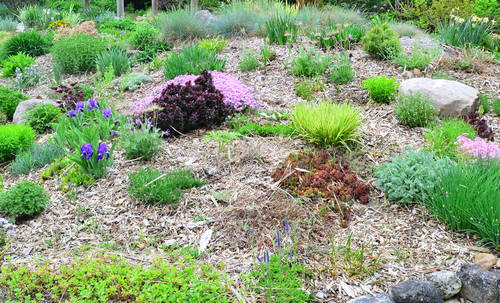Plant of the Month for March, 2020

(BUR-bur-is thun-BERG-ee-eye)
General Information:
Berberis thunbergii ‘Concorde’,adds great color to a larger rock garden. It looks good from spring to fall and can be pruned to any height that suits its location. The flowers are insignificant, but the foliage steals the show.

Berberis thunbergii 'Concorde' by Robert Pavlis
Berberis thunbergii is a Japanese species that has become invasive in the northeastern US and I have even found it in Southern Ontario. It can grow in part shade and fills in under larger trees forming impenetrable stands. The cultivar Concorde, fruits very little and does not make viable seeds, so it should not be a problem.

Berberis thunbergii 'Concorde' by Robert Pavlis
B. thunbergiiis is a tick magnet. Researchers have found ten times as many ticks in a field with barberry compared to one without the plant. This should not be an issue with Concorde growing in a manicured rock garden.
Concorde leafs out red and turns a dark maroon-purple with exposure to light. Lower leaves that are not exposed to sun will turn green, but these are not visible unless you reach in and move some branches aside. It is multi-stemmed and forms a nice tight clump. It requires no annual maintenance and once established it is very drought tolerant.

Berberis thunbergii 'Concorde', photo by David J. Stang
The Concorde Japanese Barberry can be grown into a 90 cm x 90 cm shrub over time, but it can also be pruned to almost any size. The one in the picture is about 45 cm tall but I think it could be kept as small as 10 cm with annual pruning. It is easily propagated by cuttings. As with all barberries, it does have thorns which deter deer, rodents and humans.

Berberis thunbergii invading wooded area, photo by Ontario's Invasive Species
Life Cycle: shrub
Height: 60cm (2 ft)
Bloom Time: early summer
Natural Range: Japan and eastern Asia
Habitat: woodland edges
Synonyms: Berberis thunbergii var. atropurpurea
Cultivation:
Light: part shade to full sun– best color in full sun
Soil: well drained
Water: average to dry
USDA Hardiness Zone: 3 - 10
Propagation: cuttings
Seedex availability (ORG&HPS annual Seed Exchange): n/a
